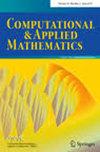优化中的灵活性和广义不确定性概述
IF 2.5
3区 数学
Q1 MATHEMATICS, APPLIED
引用次数: 12
摘要
两种新的强大的数学语言,模糊集理论和可能性理论,已经导致两种优化类型的明确纳入数据的值不是实值或概率:1)柔性优化和2)广义不确定性下的优化。我们的目的是弄清楚这两种类型是什么,做出区分,并展示如何应用它们。当需要放宽属于一个集合(优化上下文中的约束集)的数学关系的含义时,就会出现柔性优化。松弛集归属的数学语言是模糊集论。当需要表示一个模型的参数,而该模型的值仅部分或不完全已知时,就会出现广义不确定性下的优化。表示关于参数值的部分或不完全信息的自然数学语言是可能性理论。柔性优化,正如这里所描述的,包括了很多被称为模糊优化的东西,而广义不确定性下的优化包括了被称为可能性优化的东西。我们探讨了为什么柔性优化和广义不确定性下的优化是不同的重要类型的优化问题。在优化问题中,可能性理论导致了广义不确定性下的两种不同类型的优化:单分布优化和对偶分布优化。双(可能性/必要性对)分配优化是新的。数学学科分类:90C70, 65G40。本文章由计算机程序翻译,如有差异,请以英文原文为准。
An overview of flexibility and generalized uncertainty in optimization
Two new powerful mathematical languages, fuzzy set theory and possibility theory, have led to two optimization types that explicitly incorporate data whose values are not real-valued nor probabilistic: 1) flexible optimization and 2) optimization under generalized uncertainty. Our aim is to make clear what these two types are, make distinctions, and show how they can be applied. Flexible optimization arises when it is necessary to relax the meaning of the mathematical relation of belonging to a set (a constraint set in the context of optimization). The mathematical language of relaxed set belonging is fuzzy set theory. Optimization under generalized uncertainty arises when it is necessary to represent parameters of a model whose values are only known partially or incompletely. A natural mathematical language for the representation of partial or incomplete information about the value of a parameter is possibility theory. Flexible optimization, as delineated here, includes much of what has been called fuzzy optimization whereas optimization under generalized uncertainty includes what has been called possibilistic optimization. We explore why flexible optimization and optimization under generalized uncertainty are distinct and important types of optimization problems. Possibility theory in the context of optimization leads to two distinct types of optimization under generalized uncertainty, single distribution and dual distribution optimization. Dual (possibility/necessity pairs) distribution optimization is new. Mathematical subject classification: 90C70, 65G40.
求助全文
通过发布文献求助,成功后即可免费获取论文全文。
去求助
来源期刊

Computational & Applied Mathematics
Mathematics-Computational Mathematics
CiteScore
4.50
自引率
11.50%
发文量
352
审稿时长
>12 weeks
期刊介绍:
Computational & Applied Mathematics began to be published in 1981. This journal was conceived as the main scientific publication of SBMAC (Brazilian Society of Computational and Applied Mathematics).
The objective of the journal is the publication of original research in Applied and Computational Mathematics, with interfaces in Physics, Engineering, Chemistry, Biology, Operations Research, Statistics, Social Sciences and Economy. The journal has the usual quality standards of scientific international journals and we aim high level of contributions in terms of originality, depth and relevance.
 求助内容:
求助内容: 应助结果提醒方式:
应助结果提醒方式:


